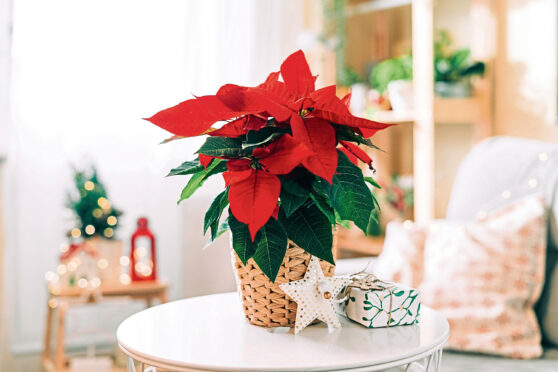
For many people Christmas means just one thing – the annual struggle to keep leaves from falling off their poinsettia.
Despite their popularity, these colourful festive favourites can prove tricky to maintain in good condition and it isn’t always easy to work out what they need.
When dealing with any poinsettia, whether it’s a traditional red and green variety or one of the many other colour options, including white or peach, it is always worth remembering that this plant is native to Mexico and if there’s one thing it must have is warmth.
For that reason, don’t buy the poinsettia that’s been displayed nearest to the door in the shop and make sure that you cover the top of it with wrapping paper or polythene until you get it home to protect it from icy blasts.
Once indoors find it the warmest spot in the house, out of reach of any draughts and away from windowsills where the temperature can plummet at night.
This is a forest plant that thrives in filtered sunlight, but here where light levels are naturally low in winter it can take all the daylight that you can give it.
Poinsettias need humidity but hate to be waterlogged, so mist them daily and water them little and often rather than giving them an occasional long drink.
Tip out any water that remains in the saucer beneath them after watering and check daily to see if they need a top-up, only watering them if the compost is dry. And make sure the water is at room temperature otherwise your plant could go into cold shock.
After four weeks apply a liquid feed once every 10 days and in spring prune it lightly and repot it, pinching out the tips as new growth develops.
Keep it in a cool and light position over the summer.
In order for the leafy bracts to colour up, you’ll need to put it on a strict regime of 15 hours of complete darkness from the start of October until the end of November. The easiest way to do this is to cover the plant with a box from 5pm until 8am daily.
Then, once it has regained its splendid colours, you can put it back on display and enjoy it all over again next Christmas.
The Christmas cherry (Solanum capsicastrum) is a popular winter houseplant and its bright fruits make a cheerful display.
It likes to be kept on the cool side, so place it where it won’t be stressed by fires or radiators and ensure that its attractive but toxic berries are out of reach of children and pets.

Enjoy the convenience of having The Sunday Post delivered as a digital ePaper straight to your smartphone, tablet or computer.
Subscribe for only £5.49 a month and enjoy all the benefits of the printed paper as a digital replica.
Subscribe